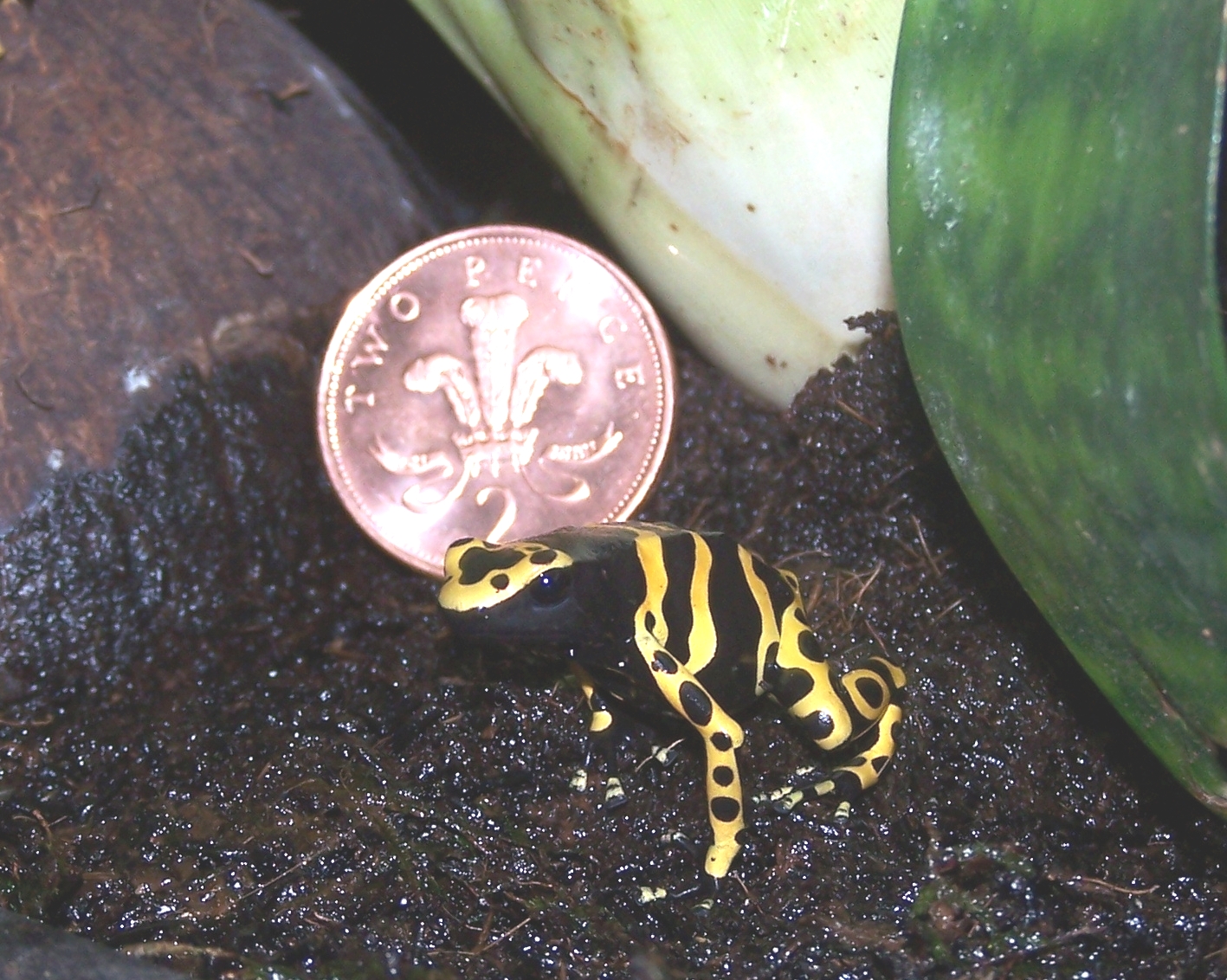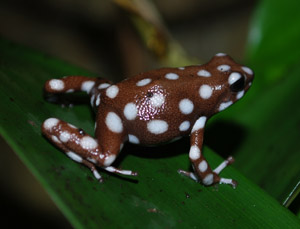|
Dendrobates
''Dendrobates'' is a genus of poison dart frogs native to Central and South America. It once contained numerous species, but most originally placed in this genus have been split off into other genera such as ''Adelphobates'', ''Ameerega'', ''Andinobates'', ''Epipedobates'', ''Excidobates'', ''Oophaga'', ''Phyllobates'' and ''Ranitomeya'' (essentially all the brightly marked poison dart frogs; i.e. excluding the duller genera in the family like ''Colostethus'' and ''Hyloxalus ''Hyloxalus'' is a genus of poison dart frogs, family Dendrobatidae. The genus is distributed in Central and South America, from Panama south to Peru (along the Pacific coast), along with Venezuela, Colombia, and Ecuador. They also inhabit the ea ...''), leaving only five large to medium-sized species in the genus ''Dendrobates''. All the other genera used to be grouped in with ''Dendrobates'' because it was previously thought that all brightly colored poison dart frogs came from the same ancestor but this ... [...More Info...] [...Related Items...] OR: [Wikipedia] [Google] [Baidu] |
Poison Dart Frogs
Poison dart frog (also known as dart-poison frog, poison frog or formerly known as poison arrow frog) is the common name of a group of frogs in the family Dendrobatidae which are native to tropical Central and South America. These species are diurnal and often have brightly colored bodies. This bright coloration is correlated with the toxicity of the species, making them aposematic. Some species of the family Dendrobatidae exhibit extremely bright coloration along with high toxicity, while others have cryptic coloration with minimal to no amount of observed toxicity. The species that have great toxicity derive this feature from their diet of ants, mites and termites. However, other species that exhibit cryptic coloration, and low to no amounts of toxicity, eat a much larger variety of prey. Many species of this family are threatened Threatened species are any species (including animals, plants and fungi) which are vulnerable to endangerment in the near future. Species th ... [...More Info...] [...Related Items...] OR: [Wikipedia] [Google] [Baidu] |
Dendrobates Tinctorius
The dyeing dart frog, dyeing poison dart frog, tinc (a nickname given by those in the hobby of keeping dart frogs), or dyeing poison frog (''Dendrobates tinctorius'') is a species of poison dart frog. It is among the largest species, reaching lengths of . This species is distributed throughout the eastern portion of the Guiana Shield and Venezuela, including parts of Guyana, Suriname, Brazil, and nearly all of French Guiana. Etymology The specific name, ''tinctorius'', comes, however not from the variety of colors, but from the legends of some indigenous tribes. It has been said that tribe members used the frog poisons to cause green parrot feathers to grow different colors. Poison Like most species of the genus ''Dendrobates'', ''D. tinctorius'' is highly toxic if consumed. It produces pumiliotoxins and allopumiliotoxins that the frog uses for self-defense. While pumiliotoxins are weaker than their derivative allopumiliotoxins and the batrachotoxins secreted by '' Phyllob ... [...More Info...] [...Related Items...] OR: [Wikipedia] [Google] [Baidu] |
Dendrobates
''Dendrobates'' is a genus of poison dart frogs native to Central and South America. It once contained numerous species, but most originally placed in this genus have been split off into other genera such as ''Adelphobates'', ''Ameerega'', ''Andinobates'', ''Epipedobates'', ''Excidobates'', ''Oophaga'', ''Phyllobates'' and ''Ranitomeya'' (essentially all the brightly marked poison dart frogs; i.e. excluding the duller genera in the family like ''Colostethus'' and ''Hyloxalus ''Hyloxalus'' is a genus of poison dart frogs, family Dendrobatidae. The genus is distributed in Central and South America, from Panama south to Peru (along the Pacific coast), along with Venezuela, Colombia, and Ecuador. They also inhabit the ea ...''), leaving only five large to medium-sized species in the genus ''Dendrobates''. All the other genera used to be grouped in with ''Dendrobates'' because it was previously thought that all brightly colored poison dart frogs came from the same ancestor but this ... [...More Info...] [...Related Items...] OR: [Wikipedia] [Google] [Baidu] |
Dendrobates Leucomelas
The yellow-banded poison dart frog (''Dendrobates leucomelas''), also known as yellow-headed poison dart frog or bumblebee poison frog, is a poison dart frog from the genus ''Dendrobates'' of the family Dendrobatidae. Distribution and habitat ''Dendrobates leucomelas'' is a common poison dart frog found in the northern part of continent of South America, most notably in Venezuela. It is also found in parts of Guyana, Brazil, and the extreme easternmost part of Colombia. This amphibian is normally found in very humid conditions in tropical rain forests, close to fresh water. It is often found on flat rocks, trees, plants (notably bromeliads), and the leaf litter of the forest floor. During the dry season, specimens are known to congregate in damper places, such as under rocks or fallen tree trunks. The ''D. leucomelas natural habitat is tropical, and not subject to great seasonal temperature variations. Typically, temperature variances are related to elevation and time of day, ... [...More Info...] [...Related Items...] OR: [Wikipedia] [Google] [Baidu] |
Dendrobates Auratus
The green-and-black poison dart frog (''Dendrobates auratus''), also known as the green-and-black poison arrow frog and green poison frog (among others), is a brightly colored member of the order Anura native to Central America and northwestern parts of South America. This species has also been introduced to Hawaii. It is one of the most variable of all poison dart frogs next to '' Dendrobates tinctorius'' and some '' Oophaga'' spp. It is considered to be of least concern from a conservation standpoint by the International Union for Conservation of Nature. Description The green-and-black poison dart frog has the typical appearance of the members of its family. Males average , while females are slightly larger, averaging an inch or longer. The green-and-black poison frog typically has mint-green coloration; however, this pigment can also be forest, lime, emerald green, turquoise, or even cobalt blue or pale yellow. Mixed with this typically green are splotches of dark color, r ... [...More Info...] [...Related Items...] OR: [Wikipedia] [Google] [Baidu] |
Dendrobates Nubeculosus
The Rockstone poison dart frog (''Dendrobates nubeculosus'') is a poorly known species of dendrobatid frogs endemic to Guyana. As it is known from only one specimen, very little information is currently available on ''D. nubeculosus''. It has been suggested to be one of the most poorly known species in the world. Description ''D. nubeculosus'' is a small to medium-sized poison dart frog; larger than many of its contemporary '' Ranitomeya'' species, but smaller than the other members of the genus ''Dendrobates''. The holotype specimen measures 2.5 centimetres in length, and the species' size range is unknown. It is reasonably certain that, like other members of the genus ''Dendrobates'', ''D. nubeculosus'' females are larger than males, but even this is open to speculation. The holotype is primarily black or dark brown, with irregularly shaped blue splotches on the dorsum, and it is mottled blue and black laterally, with a solid black ventral surface. It is unclear whether, as ... [...More Info...] [...Related Items...] OR: [Wikipedia] [Google] [Baidu] |
Dendrobates Truncatus
The yellow-striped poison frog (''Dendrobates truncatus'') is a species of frog in the family Dendrobatidae. It is endemic to Colombia. Its natural habitats are subtropical or tropical dry forests, subtropical or tropical moist lowland forests, subtropical or tropical moist montane forests, intermittent freshwater marshes, and plantation A plantation is an agricultural estate, generally centered on a plantation house, meant for farming that specializes in cash crops, usually mainly planted with a single crop, with perhaps ancillary areas for vegetables for eating and so on. Th ...s. References Dendrobates Amphibians of Colombia Amphibians described in 1861 Taxonomy articles created by Polbot {{Dendrobatidae-stub ... [...More Info...] [...Related Items...] OR: [Wikipedia] [Google] [Baidu] |
Adelphobates
''Adelphobates'' is a small genus of poison dart frogs. They are found in the central and lower Amazon basin of Peru and Brazil, possibly Bolivia. It was originally erected as a sister group to the ''Dendrobates'' and ''Oophaga'' genera. The validity of the genus is still being discussed, with the alternative being "''Dendrobates galactonotus'' group" within ''Dendrobates''. One species originally placed in this genus as '' Adelphobates captivus'' has since been moved to the genus ''Excidobates'' erected in 2008. Etymology ''Adelphobates'' is from the Ancient Greek, ''adelphos'' (brother or twin) and ''bates'' (walker or climber)."Brothers" refers to Charles W. Myers and John W. Daly, two unrelated scientists directly involved with studies of the species. Biology All members have conspicuous, vibrant coloration, and smooth skin. A peculiar feature of their reproduction is that tadpoles are transported to Brazil nut The Brazil nut (''Bertholletia excelsa'') is a South America ... [...More Info...] [...Related Items...] OR: [Wikipedia] [Google] [Baidu] |
Ranitomeya
''Ranitomeya'' is a genus of dart poison frogs found in Panama and South America south to Peru and Brazil, possibly into Bolivia. Taxonomy In 2006 Grant ''et al.'' revised the systematics of poison dart frogs and placed many species formerly classified in the genera ''Dendrobates'', '' Minyobates'' and ''Phyllobates'' in ''Ranitomeya''. In 2011 Brown and colleagues, following other scientists who assumed the existence of two distinct clades in ''Ranitomeya'', erected the genus '' Andinobates'' for 12 species of ''Ranitomeya''. ''Ranitomeya'' and ''Andinobates'' frogs can be distinguished from those in genera such as ''Dendrobates'' in that they are generally smaller, have more than two colors, and seem to glitter if viewed from certain angles. ''Ranitomeya'' is widespread in the Amazon basin, whereas ''Andinobates'' species are found only in the northern Andes down to Central America. Description Adults measure no more than in snout–vent length and are typically brightly col ... [...More Info...] [...Related Items...] OR: [Wikipedia] [Google] [Baidu] |
Excidobates
''Excidobates'' is a genus of poison dart frogs endemic to the Marañón River drainage in Peru and Ecuador, South America. At one time members of this genus were classified as ''Dendrobates ''Dendrobates'' is a genus of poison dart frogs native to Central and South America. It once contained numerous species, but most originally placed in this genus have been split off into other genera such as ''Adelphobates'', ''Ameerega'', ''Andi ...''. A characteristic of this genus is the presence of pale, ovoid spots on the under surface of the thighs. Poison frogs, Dendrobates.org Species The following species are included in the genus:References [...More Info...] [...Related Items...] OR: [Wikipedia] [Google] [Baidu] |
.jpg)





